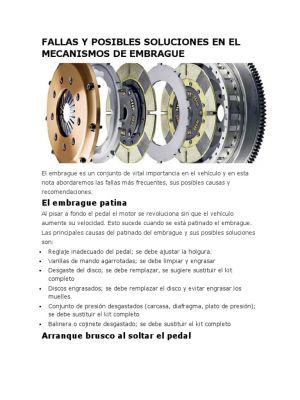
The clutch pedal is an essential part of a vehicle's transmission system. When this pedal presents problems, it may be indicative of a malfunction in the clutch. In this article, we will cover the different search intentions related to the clutch pedal that stays down, the possible causes of this problem, how to detect if the clutch is worn and keys to change it. We will also analyze a specific case of an Aveo whose clutch cuts too low after changing it.
1. Clutch pedal that stays down: causes and solutions
If the clutch pedal stays down when depressed, there is probably a problem with the clutch system. The possible causes can be diverse, from excessive wear on the clutch disc to a fluid leak in the master or slave cylinder. It is important to identify the exact cause in order to effectively fix the problem.
One of the most common causes of a stuck-down clutch pedal is clutch disc wear. Over time, the disc can wear down and not make proper contact with the flywheel, causing the pedal to hang down. In this case, the solution would be to replace the clutch disc.
Another possible cause is a fluid leak in the clutch master or slave cylinder. If there is a leak in either of these cylinders, the clutch pedal may stick down due to a lack of hydraulic pressure. In this case, it will be necessary to repair the leak and bleed the clutch system to remove the air.
2. How to detect if the clutch is worn
It is important to detect if the clutch is worn to avoid major problems in the transmission system. Some signs of clutch wear include:
- The clutch pedal feels softer or harder than normal.
- The clutch slips, that is, the engine accelerates but the vehicle does not gain speed.
- The clutch makes strange noises when depressed.
- The vehicle has difficulty changing gear.
If you experience any of these symptoms, it is advisable to take the vehicle to a specialized workshop for an inspection and determine if the clutch needs to be replaced.
3. Keys to change the clutch
Changing the clutch can be a complicated process and requires technical knowledge. However, if you have a background in auto mechanics, you can try doing it yourself by following these steps:
- Raise the vehicle using a jack and secure it with jack stands.
- Disconnect either the clutch cable or the hydraulic system, depending on the type of clutch your vehicle has.
- Remove the flywheel and clutch disc.
- Replaces the clutch disc, pressure plate and thrust bearing.
- Reassemble all the parts in the reverse order.
- Purge the clutch system to remove air.
It is important to follow the manufacturer's instructions and use the right tools to perform the clutch change correctly. If you do not feel safe, it is advisable to go to a specialized workshop.
Frequently Asked Questions (FAQs)
1. How long does a clutch last?
The life of a clutch can vary depending on driving style, driving conditions and proper maintenance. In general, a clutch can last between 80,000 and 120,000 kilometers. However, it is important to watch for signs of wear and perform regular maintenance to prolong its life.
2. How much does it cost to change a vehicle's clutch?
The cost to change a vehicle's clutch can vary depending on the model and make of the vehicle, as well as the labor of the shop. On average, the cost can range from 500 to 1500 euros. It is advisable to request budgets in different workshops to obtain the best price.
3. Can I drive with a worn clutch?
It is not recommended to drive with a worn clutch, as this can cause further damage to the transmission system. If you suspect your clutch is worn, it's a good idea to take the vehicle to a shop for an inspection and determine if it needs to be replaced.
Conclusion
A sticking down clutch pedal may be indicative of problems in the clutch system. It is important to identify possible causes and take the necessary steps to fix the problem. If the clutch is worn, it is advisable to change it to avoid further damage to the vehicle. Remember that regular maintenance and proper driving can help prolong the life of the clutch.
We hope this article has been useful in solving your doubts about the problems related to the clutch pedal. If you have any additional questions, feel free to leave a comment and we'll be happy to help.
Until next time!
The Pistonudos.com team


























